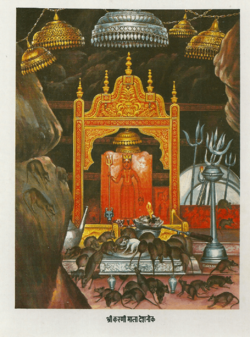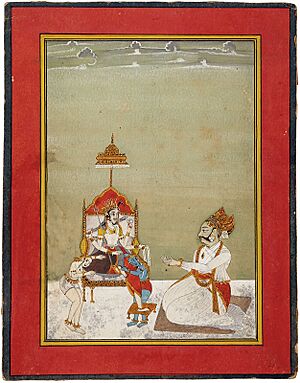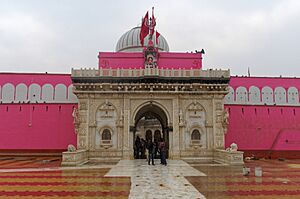Karni Mata facts for kids
Quick facts for kids Karni Mata |
|
|---|---|
| Goddess of Power and Victory Incarnation of Hinglaj | |
 |
|
| Other names | Riddhi Baisa |
| Affiliation | Charanas, Rajputs & Rajpurohits |
| Abode | Western Rajasthan(Marwar and Bikaner) |
| Weapon | Trident |
| Symbol | eagle / Sanwali |
| Mount | Lion and flanked by eagle |
| Personal information | |
| Spouse | Depa ji Rohadiya of Sathika |
| Parents | Meha ji Kiniya & Deval Bai |
Karni Mata (in Hindi: करणी माता) is a powerful Hindu Goddess of strength and victory. People also know her as Bhagwati, Mehaai, Jagdamba, and Kiniyani. She was a wise warrior who lived in Western Rajasthan between the 14th and 16th centuries.
Karni Mata is a special protector goddess for the Rajputs and Charans in northwestern India. Many believe she is an incarnation, or a living form, of the goddess Hinglaj or Durga. She is also the official deity for the royal families of Bikaner and Jodhpur.
Karniji played a big part in the history of her region. With her blessings, two important leaders, Rao Jodha and Rao Bika, started new kingdoms. These became the cities of Jodhpur and Bikaner. She even laid the foundation stones for the famous Mehrangarh Fort in Jodhpur and the Bikaner Fort. Karni Mata lived a simple, spiritual life and was highly respected by many people. Even today, soldiers from the Indian Army in the Marwar region see her as their special protector.
The most famous temple dedicated to Karni Mata is in Deshnoke. This temple and the land around it are a safe place for all living things. No one is allowed to harm any animal there. In Rajasthan, Blackbucks (a type of antelope) are considered sacred because Karni Mata is believed to protect them.
Contents
|
Karni Mata's Importance
Karni Mata teaches us about non-violence and living peacefully together. She is a very important goddess for many Rajput clans. They believe she helps their community survive tough times.
Karni Mata also had a close relationship with the Rathore rulers of Bikaner and Jodhpur. History books tell many stories of her helping rulers during battles. She also helped them form important alliances with other kingdoms. Today, the Karni Mata Temple in Deshnoke is a key meeting spot for many Charan families. After India was divided in 1947, it became harder to visit the Hinglaj temple. Because of this, the Karni Mata temple in Deshnoke became even more important for the community.
Incarnations of Goddesses
The Charan people believe that Karni Mata was an incarnation of Awad Mata. Awad Mata was an earlier incarnation of Hinglaj Mata. This means that these goddesses are connected, like different forms of the same divine being.
However, it's important to know that not all goddesses are believed to be linked in this way. Some are seen as unique and separate.
Temples of Karni Mata
Sri Karni Mata Temple in Deshnoke
The Deshnoke temple is the most important place for people to visit Karni Mata. This temple is famous for its many black rats and a few rare white rats. There are about 25,000 rats living there! These holy rats are believed to be reincarnated Charan devotees. People travel long distances to show their respect. The temple attracts visitors from all over India and curious tourists from around the world.
The main part of the temple, where the idol of Karni Mata sits, was built without cement. Its roof is made from a Jal tree. The special thing about this structure is that no mortar was used to build it. Later, kings added more to the temple. Maharaja Surat Singh made it a stronger structure. The beautiful gold door of the temple was given by Maharaja Bakhtawar Singh of Alwar. In the 20th century, Maharaja Ganga Singh renovated most of the temple.
Temra Rai Temple
This temple is dedicated to the goddess Avadji. It's located where Rao Kanha once faced difficulties. You can still see the original basket (called Karand) that Karniji used to worship Avadji there. The idol of Avadji is also in this temple.
Sati Mankumariji Temple
This temple is a memorial for Mankumariji, Karniji’s granddaughter, and her friend Sakhi. Mankumariji became a Sati when she heard her husband had died. This means she chose to end her life in a sacred way. Her friend Sakhi also joined her.
Sri Nehriji Temple in Deshnoke
Shri Nehriji is another temple in Deshnoke connected to Karniji. The word Nehriji means a dry piece of wood. This wood was brought back to life to help churn curd.
When people first arrived at Johad in Janglu, they needed tools to make ghee and churn curd from cow milk. They had pots, but they needed a 'nehri' (a Rajasthani tool for churning). Karniji asked a servant to find a piece of wood for this. The servant brought a piece of dead wood that wasn't good enough. So, Karniji planted the dead wood branch and sprinkled it with curd. The dead wood, which was a piece of a Jal tree, grew roots and became the only green Jal tree in the Deshnoke Oran (a protected village forest). You can still see marks on the tree from the sprinkled curds!
Karni Mata Temple in Mathania
This is the oldest Karni Mata temple. It was built by her follower, Amaraji Barhath of Mathania. After laying the foundation of the Mehrangarh fort in Jodhpur, Karniji stopped at Mathania on her way back to Deshnoke. Amaraji Barhath had asked her to visit. Mathania was about 12 miles from Mandore. To remember her visit, Amaraji built this temple for her. It became the first Karni Mata Temple ever. Because of Karniji's blessings, Amaraji had many children, who became known as Amrawat.
Inside the temple, people worship the foot imprints of Karni Mata.
Harsiddhi Temple in Porbandar
Once, a trader named Jhagdu Shah was sailing in the sea in the 15th century. He got caught in a big storm. He called out to Maa Karni for help. At that moment, Karni Mata was milking a cow at her home. She helped him, and he safely reached the Porbandar port. After arriving safely, Jhagdu Shah went to Maa Karni in Deshnoke to thank her. He told her he wanted to build a temple. Karni Mata told him to build the temple in Porbandar and call it Harsiddhi temple.
Karni Mata Temple in Mathura
This temple was first built by Lakhaji Barhath in the 16th century in Mathura. In the 20th century, it was rebuilt and made new by Thakur Akshay Singh Ratnu.
Karni Mata Temple by Rana Sanga in Mewar
A shrine for Karni Mata was built by the Chāraṇas in the village of Bheemal Charanan in the Mewar kingdom. The priestess there, named Viri Maa, was famous for predicting the future. When the princes of Mewar – Sanga, Jaimal, and Prithviraj – were arguing about who would become king, their uncle suggested visiting Viri Maa. They wanted her to tell them who would rule. Viri Maa predicted that Rana Sanga would become the ruler of Mewar.
However, Prince Prithviraj did not like this prediction. He badly hurt Sanga, causing him to lose sight in one eye. But in the end, Rana Sanga defeated Prithviraj and became the ruler of Mewar. He then built a temple dedicated to Karni Mata at this shrine.
Manshapurna Karni Mata Temple in Udaipur
Another temple for Karni Mata is the Shri Manshapurna Karni Mata Temple, also known as Karni Mata, Udaipur. It is located on the Machla Hills in Udaipur, Rajasthan. Between 1620 and 1628, Maharana Karan Singh built a residential area on Machla Magra to protect Udaipur. He built the temple as a symbol to mark the city's boundary and safety. For a long time, the temple was empty. But in 1997, the Shri Manshapurna Karni Mata Development Committee rebuilt it.
Karni Mata Temple in Alwar
There is another temple dedicated to Karni Mata in the historic city of Alwar, Rajasthan. It is in the center of the city, near the Sagar Palace and Bala Qila.
This temple was built by the second ruler of the Alwar State, Maharao Raja Sawai Bakhtawar Singh (who ruled from 1791 to 1815). Since then, the royal family of Alwar has worshipped Karni Mata. They even built two temples for her in Bala Qila and Rajbhawan.
Shree Madh Khurad Dham in Nagaur
Another old temple for Maa Karni is in Khurad, about 12 km northeast of Gachhipura in the Nagaur area of Rajasthan. The original temple was built by the Cāraṇas of Khurd village. A woman named Inder Baisa, who lived in the 20th century, was seen as an incarnation of Karni Mata by her followers. The Bikaner ruler Maharaja Ganga Singh was also one of her devotees. On her advice, he gave money in 1930 to fix and improve the Karni Mata temple. Ganga Singh asked his Army Minister, Hari Singh of Sattasar, to oversee this work. The temple is built like a fort and is mostly made of white marble, as it is close to the marble city of Makrana.
Images for kids
See also
 In Spanish: Karni Mata para niños
In Spanish: Karni Mata para niños






